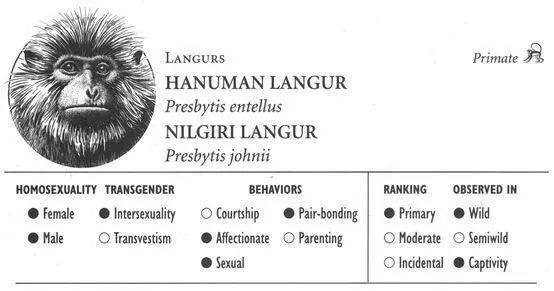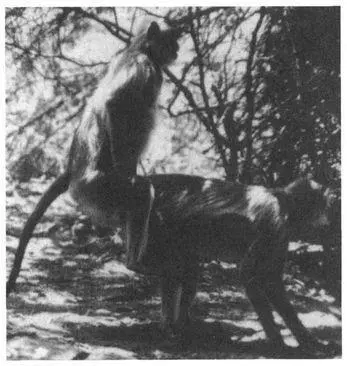Koyama, N. (1971) “Observations on Mating Behavior of Wild Siamang Gibbons at Fraser’s Hill, Malaysia.” Primates 12:183-89.
Leighton, D. R. (1987) “Gibbons: Territoriality and Monogamy.” In B. B. Smuts, D. L. Cheney, R. M. Seyfarth, R. W. Wrangham, and T. T. Struhsaker, eds., Primate Societies , pp. 135-45. Chicago: University of Chicago Press.
Mootnick, A. R., and E. Baker (1994) “Masturbation in Captive Hylobates (Gibbons).” Zoo Biology 13:345- 53.
Palombit, R. (1996) “Pair Bonds in Monogamous Apes: A Comparison of the Siamang Hylobates syndacty - lus and the White-handed Gibbon Hylobates lar.” Behavior 133:321-56.
———(1994a) “Dynamic Pair Bonds in Hylobatids: Implications Regarding Monogamous Social Systems.” Behavior 128:65-101.
———(1994b) “Extra-pair Copulations in a Monogamous Ape.” Animal Behavior 47:721-23.
Raemaekers, J. J., and P. M. Raemaekers (1984) “Vocal Interaction Between Two Male Gibbons, Hylobates lar.” Natural History Bulletin of the Siam Society 32:95-106.
Reichard, U. (1995a) “Extra-pair Copulation in Monogamous Wild White-handed Gibbons ( Hylobates lar ).” Zeitschrift für Säugetierkunde 60:186-88.
———(1995b) “Extra-pair Copulation in a Monogamous Gibbon ( Hylobates lar ).” Ethology 100:99-112.

HANUMAN LANGUR
IDENTIFICATION: A medium-sized monkey with a silver-gray or brown coat, black face, slender limbs, and a long tail (over 3 feet). DISTRIBUTION: Throughout India, Pakistan, Bangladesh, Sri Lanka, Burma. HABITAT: Scrub and deciduous forests. STUDY AREAS: Numerous locations in India, including Jodhpur, Abu, Kumaon Hills; Polonnaruwa, Sri Lanka; Melemchi, Nepal; University of California-Berkeley.
NILGIRI LANGUR
IDENTIFICATION: Similar to Hanuman Langur but with shiny black fur, a light brown hood, and a prominent brow tuft. DISTRIBUTION: Southwestern India; vulnerable. HABITAT: Montane evergreen rain forests, woodlands. STUDY AREAS: Nilgiri district, Mundanthurai Tiger Reserve, Anaimalai Wildlife Sanctuary, India.
Social Organization
Hanuman Langurs live in cosexual troops (some contain only one male) and also in all-male groups. The latter typically include up to 30 or more individuals; about 20 percent of the population in some areas lives in male-only groups. Nilgiri Langurs live in both cosexual troops (usually eight to nine monkeys each, with one or two adult males) and same-sex groupings (usually two or three males, occasionally more, constituting about a quarter to a third of the adult males). Troop life and stability generally revolve around the females; males are distinctly peripheral to the overall social system, playing only a minor role in defending the troop and minimally helping raise the young.
Description
Behavioral Expression: Homosexual mounting is a prominent feature of female interactions in Hanuman Langurs. One female climbs on the back of another and begins pelvic thrusting. Unlike in other species that engage in homosexual mounting, the female does not rub her genitals on the rump of the other female, but rather thrusts against her buttocks. The mounter may experience indirect stimulation of the area surrounding her clitoris, while the mountee may have direct clitoral stimulation from the female on top of her. In many ways such mounts resemble heterosexual matings, for example in their duration (5 to 10 seconds), number of pelvic thrusts (two to eleven), the grunting and grimacing of the mounter, and the JUMPING DISPLAY, which often precedes or follows. In other respects, however, homosexual mountings are strikingly different. For example, most heterosexual matings are solicited by the female, who lowers her head and shakes it while presenting her hindquarters to the male. While a similar solicitation occurs in about 13 percent of mounts between females, the majority (79 percent) are initiated by the mounting female. In both homosexual and heterosexual mounts, the partners groom following a mount; however, between females the mounter usually grooms the mountee, while in heterosexual mounts, the mountee (female) typically grooms the mounter (male). Finally, only about 30 percent of homosexual mounts are interrupted by other individuals; in contrast, more than 80 percent of heterosexual copulations are harassed by other animals trying to disrupt (and prevent) the mating. Up to seven animals of all ages and sexes may converge on an opposite-sex mating pair and directly attack the animals, slapping them, trying to push the male off or chase the female out from under him, and even kicking the male’s testicles.
All females participate freely in homosexual mounting, including lactating, pregnant, menstruating, ovulating, and nonovulating females. This behavior is especially common among mothers, who have developed a special “baby-sitting” system: they transfer their young to other individuals in the troop (usually other females but sometimes males) for a short time (a similar pattern is found in Nilgiri Langurs). This allows them to engage in homosexual (and other) activities. Most mounting between females occurs among adults, though some involves adults with juveniles (up to four years old), usually with the younger female mounting the older one. Although most homosexual participants are unrelated, some mountings are incestuous, mostly between half sisters (about 27 percent of all lesbian mounts) and, more rarely, between mother and daughter (about 1 percent of mounts); heterosexual matings are virtually never incestuous.
A female Hanuman Langur in India mounting another female

Male Hanuman Langurs mount each other as well, especially in the all-male bands. Unlike homosexual mounting between females, this activity is typically initiated by the mountee, who invites another male to mount him by performing a head-shaking display (sometimes combined with small jumps and “snoring” vocalizations). Mounting often involves one male rubbing and thrusting his erect penis against the other’s body and may be accompanied by a number of affectionate activities that are typically associated with sexual arousal. These include embracing (in which one male buries his head in the chest or shoulder of another), mouth-to-mouth contact or “kissing,” reciprocal grooming (often accompanied by erections), and touching or grooming of the genitals with the hand or lips. Males also “cuddle,” one sitting closely behind the other, resting his head on the back of the male seated between his legs while touching his loins. Hanuman males sometimes form DOUS—companionships in which two males live and travel together, visiting troops in other areas or sometimes settling into all-male bands. Some duos are short-lived (a month or less), others more long-lasting.
Male Nilgiri Langurs also interact erotically with each other in a number of ways, usually incorporating three types of activities: grooming, embracing, and mounting. These are not entirely separate behaviors, and they often combine with each other. Grooming is an intensely pleasurable, relaxing, and arousing experience: one or both males usually get an erection during grooming, and this may lead to ejaculation (a male may even eat his own semen afterward). In embracing, one monkey runs up to another and gives him a long, clinging hug; this is often combined with grooming and has a noticeable soothing effect. Male Nilgiri Langurs also mount each other, using the same position as for heterosexual intercourse. One male may directly approach another male and present his hindquarters to the other, or else he may go through a more stylized presentation known as REAR-END FLIRTATION, in which he slowly walks by the other male and turns his hindquarters toward him as he passes by. During same-sex mounting, one male climbs on top of the other’s rump, grabbing the mounted monkey by the ankles with his feet while making pelvic thrusts (often simultaneously mouthing his back); the mountee sometimes looks or reaches back to grasp the other male. Following mounting, the monkeys often groom or embrace-groom. In cosexual troops with more than one male, two males who engage in homosexual mounting may cooperate in launching attacks against males in neighboring groups.
Читать дальше














